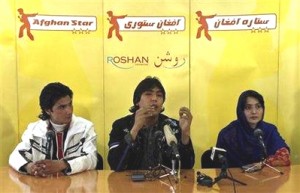
I had a fascinating conversation yesterday with Arnd Wachter, Director/Producer of the film “Crossing Borders” via Skype. We spoke about the power of film and how it can be used in the classroom as a tool to allow students, whether or not they study abroad, to get a flavor for another country, culture, language, and to open up hours and hours of dialogue about their stereotypes of others.
I recently discovered a new film to add to the “must see” list of documentaries that must be added to your toolbox! “Afghan Star” is the story of a national, televised singing competition to search for the latest singing sensation, the next pop star in Afghanistan (think along the lines of “American Idol”.) This is certainly a topic your students can relate to! Many young people in the US have not voted in a Presidential election, but can tell you how many times they voted for Adam Lambert in the US version of this competition. The TV show “Afghan Star” is so popular in Afghanistan that more than 1/3 of the entire country watched the finale. Here is the film’s trailer:
“Afghan Star” won 2 major awards at the 2009 Sundance film festival. The film’s director, Havana Marking, focuses on 4 finalists in the competition – Setara, Rafi, Lema and Hameed. By doing so, we get a glimpse of what drives each individual to compete and what winning would mean. We hear the stories of life under the Taliban and how they were not permitted to watch television, sing or dance until the ban was lifted in 2004. We see examples of how women have lost much of their individual freedom. Participants represent many different ethnic groups in Afghanistan (Pashtuns, Hazaras, Tajiks, etc). Witnessing contestants support each other in ways that they might not have done in their daily lives quickly illustrates how much more this pop culture show means in Afghanistan.
There are many directions that classroom discussion can go once this film is viewed. Two of the four main characters, Setara and Lema, are women; This puts them at risk for even participating in such a show. Dancing is not permitted in this culture, and Satara pushes the boundaries of this rule in an effort to follow her desire to self express. This is one of the most difficult parts of this film for Westerners – observing the society’s reaction to a woman’s desire to dance while she sings. It is a topic that can fill a semester of dialogue in gender studies, religious studies, sociology and history courses. Students can explore their impressions of Afghanistan’s attempts to find peace after decades of war. The TV station that produces “Afghan Star” is a topic of focus for media students. How does this TV station (Tolo) deal with the direction given by the government and how does that differ from what happens at home? What are the challenges of texting in votes in a war torn country? What might youth experience by voting – which is possibly their first act of democracy in their young lives? There is much to discuss!
Singing and freedom have been documented in the shaping of countries in the past. For example, you may have seen the documentary about the non-violent Singing Revolution in Estonia (another excellent film.) Estonia’s ability to sing to share a message of nationalism and unity somehow prevented very tense situations with the Russians from turning violent. For Afghanistan, singing is also sign of freedom. “Afghan Star” shows us the power of singing, the media, youth and a country’s desire to move forward after a very painful history.
Use this film in your classroom. For students who watch American Idol, this film about Afghanistan’s counterpart will provide a springboard into current events in Afghanistan. Getting a taste of these four characters makes you want to know more about them and their homeland. And it forces you reflect on how incredibly brave and ready they are to challenge the status quo by joining this competition.
Oh, and did I mention that the music is fabulous? 🙂
